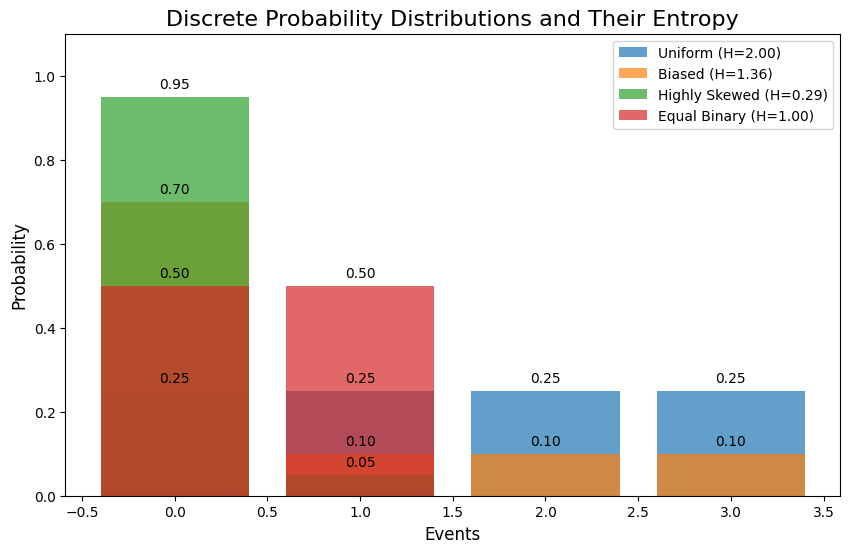Problem Description
In information theory, Shannon entropy quantifies the amount of uncertainty in a probability distribution.
It is given by the formula:
H(X)=−n∑i=1P(xi)log2P(xi)
- P(xi) is the probability of the i-th event.
- H(X) is the entropy in bits.
We will:
- Calculate the Shannon entropy of a discrete probability distribution.
- Visualize how entropy changes with different probability distributions.
Python Solution
1 | import numpy as np |
Explanation of the Code
Shannon Entropy Calculation:
- The function
shannon_entropy()takes a list of probabilities as input. - It ensures the input is valid (probabilities sum to 1 and are non-negative).
- The entropy formula is implemented using (−∑P(x)log2P(x)), with a small offset (1e−10) to handle probabilities of zero.
- The function
Example Distributions:
- Uniform: All events are equally likely ([0.25,0.25,0.25,0.25]).
- Biased: One event dominates ([0.7,0.1,0.1,0.1]).
- Highly Skewed: One event is almost certain ([0.95,0.05]).
- Equal Binary: Two equally likely events ([0.5,0.5]).
Visualization:
- Each distribution is plotted as a bar chart, with labels showing the probabilities and their corresponding entropies.
Results
Entropy Values:
Entropy of Uniform distribution: 2.0000 bits Entropy of Biased distribution: 1.3568 bits Entropy of Highly Skewed distribution: 0.2864 bits Entropy of Equal Binary distribution: 1.0000 bits
- Uniform Distribution: (H=2.0,bits) (Maximum entropy for 4 events).
- Biased Distribution: (H=1.3568,bits).
- Highly Skewed Distribution: (H=0.2864,bits) (Almost no uncertainty).
- Equal Binary Distribution: (H=1.0,bits).
Graph:
- The bar chart shows the probability distributions for each example.
- Entropy values are displayed in the legend.
Insights
Uniform Distribution:
- Maximizes entropy since all events are equally likely.
- Maximum uncertainty about the outcome.
Biased and Highly Skewed Distributions:
- Lower entropy as probabilities become more uneven.
- Greater certainty about likely outcomes.
Equal Binary Distribution:
- Entropy is 1 bit, which aligns with the classic case of a fair coin toss.
Conclusion
This example illustrates how entropy quantifies uncertainty in probability distributions.
It provides insights into how information theory applies to real-world problems like communication systems, cryptography, and data compression.
The Python implementation and visualization make these concepts clear and accessible.
